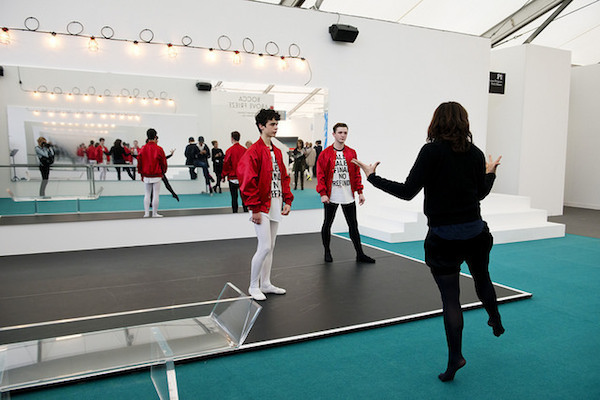
Photo: Linda Nylind Courtesy of Linda Nylind/Frieze
Artists’ projects have become an essential part of art fairs all over the globe, and the trend shows no signs of abating. These type of interventions, intended to disrupt (perhaps even challenge) the logic of the art fair, offer a welcome respite from the dizzying survey of booths and relentless schmoozing that these occasions often turn into.
Among such programs, Frieze Projects has been a pioneer, launching in 2003 alongside the very first edition of the London fair. This year, the site-specific, commission-based program of artists’ interventions across the fair and at offsite locations has been carefully selected by Frieze Projects curator Nicola Lees—the former senior curator of public programs at the Serpentine Gallery—who has placed a strong emphasis on performance-based and dance works.
“I am interested in artists, and in listening to what artists have to say,” Lees told artnet News. “The fair is a really interesting context to enact the idea of ‘liveness,’ because of its durational aspect. Everyone will have a different experience of the projects. Some visitors will see some parts that others won’t. The projects can change and evolve, and there is a sense of freedom about it; they become spaces of autonomy dotted around the fair.”
The onsite projects by Nick Mauss, Mélanie Matranga, Sophia Al Maria, and Jonathan Berger, all focus on performance and on generating spaces for social interaction.
“Mauss’s piece comes from the idea of ongoing rehearsal, and is a great example of an artist collaborating with dancers to create a new work.” Lees explained. “While curating the projects I have thought a lot about the word ‘contamination,’ which comes from the Ballets Russes, when artists would go into the theater and collaborate on a piece. Nowadays, contemporary artists are following a tradition stemming from Merce Cunningham and Meredith Monk, who brought dance into the gallery space. This is what we have been focusing on this year.”
Mélanie Matranga’s A to B coffee at Frieze Projects 2014.
Photo: Lorena Muñoz-Alonso.
In that vein, Mauss’s work creates a “living stage” in which several performances take place throughout the fair. A ballet featuring dancers from the National Youth Ballet of Great Britain is accompanied and interrupted by newly commissioned texts and music performed by Kim Gordon and Juliana Huxtable.
Nearby, Mélanie Matranga’s fantastic A to B Coffee project does what it says on the tin: a booth has been turned into a rather cozy café where one can sit, have a free coffee, surf the web, and make friends. The café, which the artist uses to reflect on (and humanize) the art fair context, is the physical remainder of another part of the project, which took place during the construction of the fair. Matranga, the inaugural Frieze Artist Award winner, filmed a story of young love and confusion among the empty booths, yet-to-be-carpeted-floors, and dormant portaloos. The resulting video is being released in chapters on the Frieze website throughout the duration of the fair.
Sophia Al Maria’s piece at Frieze Projects 2014
Photo: Lorena Muñoz-Alonso
Elsewhere, two sunglasses-clad youngsters are dragging a trolley with an arcane television monitor on top of it through the aisles of the fair as part of a bizarre tour courtesy of the artist Sophia Al Maria. The monitor is showing a film of a huge eye, Big Brother style, with a voice-over that tells us of a dystopian, sci-fi scenario in which the human race is on the brink of extinction. Al Maria uses this somber narrative to address several topics, including the art fair context (again), climate change, and accelerated consumerism. “Art can offer immortality,” says the voice-over towards the end of the tour. “But not to those who own it”. That must have given more than one collector pause.
“We treat the projects as we would in a museum or gallery space.” Lees said. “We are interested in working with the artists to develop something that is productive for them as well. What’s interesting for Nick Mauss, for example, is that this is his first real life performance work. We are all learning, trying new things out. That’s what Frieze Projects is really about, rather than whether something is good, or bad, or successful.”